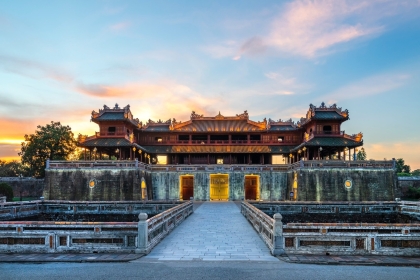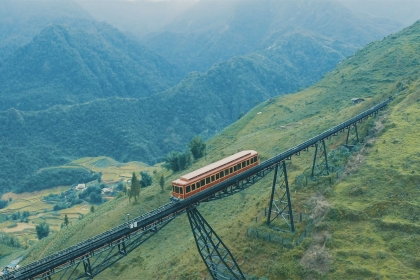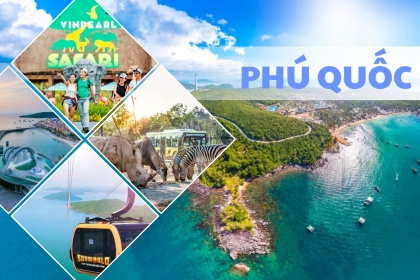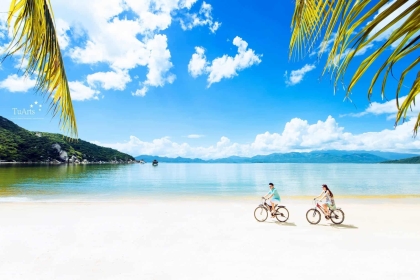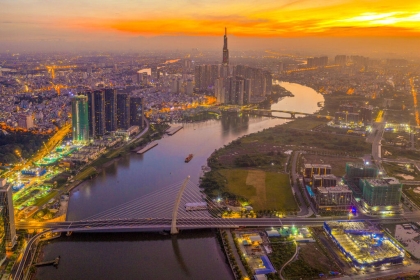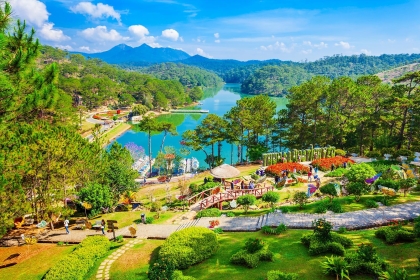Vietnam Travel Guide 2024-2025 - Explore Freely, Worry-Free About the Price with TVT Travel
This document is a travel guide for Vietnam for the years 2024-2025, published by TVT TRAVEL. It provides information on various travel destinations, hotel and resort options, and other services like ticket booking and car rentals.
The guide is structured by region: North, Central, and South Vietnam. For each region, it lists popular tourist destinations. For example, North Vietnam includes Ha Giang, Ninh Binh, and Ha Long, while Central Vietnam features Da Nang, Nha Trang, and Hue, and the South has destinations like Ho Chi Minh City, Phu Quoc, and Phan Thiet. The guide also details ideal travel times for specific locations.
Deciding on a destination and the right time to go is always a difficult problem for many people. The best part of traveling is when the weather is great or the scenery is beautiful. Below is a 12-month guide to traveling in Vietnam so you can get a head start and plan your trip for 2024-2025 with TVT Travel.
January Travel:
.jpg)
Da Lat's Enchanting Cherry Blossom Season
The most ideal Vietnamese destination in January has to be Da Lat during its cherry blossom season. For the locals of Da Lat, the cherry blossoms are always the most beautiful flowers of the year. Starting in late winter, the trees shed all their leaves, leaving behind spindly branches that then suddenly burst into vibrant blooms as spring arrives. This is also the main reason many social media enthusiasts flock to Da Lat from late December to early January. At that time, the city becomes covered in a dreamy pink hue, bringing a fresh, energetic feeling for a radiant spring.
The cherry blossoms present a different kind of beauty at every moment of the day. In the early morning, dewdrops lingering on the petals give them a delicate and mysterious beauty. When the sun rises, the petals return to their true color of soft pink, fluttering in the wind and captivating the hearts of travelers who find it hard to leave.
Pure White Plum and Apricot Blossoms in Moc Chau
Another must-visit Vietnamese destination in January is Moc Chau, with its season of pure white plum and apricot blossoms. You have to see it in person to truly understand that Moc Chau at that time is a genuine paradise.
Amidst the vast, lush green expanse of the sky and the midland mountains, ethereal white patches of delicate plum and apricot petals appear, subtly hidden in the mist.
Just a strong gust of wind can easily carry these petals into the air, creating a shimmering, magical scene over the Moc Chau plateau that is truly unparalleled.
Sa Dec: A Bustling Flower Village in Full Bloom
Anyone who wants to admire the beauty of thousands of flowers blooming at once cannot miss Sa Dec Flower Village—the largest flower hub in the Southern region, especially during the Lunar New Year. Located in Tan Quy Dong commune, Sa Dec city, Dong Thap province, this is a centuries-old traditional craft village. Situated along the Tien River, which provides year-round breeze, fertile alluvium, and abundant sunlight, it's known as the "land of ornamental flowers." The rich soil and favorable climate help all the beautiful flowers thrive and show off their colors and fragrances. Sa Dec Flower Village boasts around 2,000 different species of flowers and nearly 2,000 households working in the trade, contributing significantly to the agricultural production value of the city. The flower-growing area spans about 85 hectares. The village supplies a large quantity of ornamental plants and flowers for Lunar New Year to the provinces of the Mekong Delta and Ho Chi Minh City.
The flowers are often grown on trellises above water fields, which makes irrigation easy and keeps the flowers moist. Farmers use small boats to transport flowers from the trellises to the riverbank. The flowers are then gathered by the Sa Dec River and transported by truck or boat. During harvest season, the atmosphere in the village becomes lively and bustling. Every Lunar New Year, tourists and photographers from all over gather here to admire the vibrant flowers and shop for festive plants. The magnificent, colorful flower carpets stretching as far as the eye can see are a sight to behold.
Visiting the Lai Vung Tangerine Gardens
Lai Vung is a district in the south of Dong Thap province, long known as a gentle land, rich in cultural traditions and tourism potential. Lai Vung is famous for its fruit-laden pink tangerine gardens and the meandering, winding canals that are a characteristic feature of the Mekong Delta's riverine landscape.
Located between two major rivers, the Tien and Hau rivers, Lai Vung is blessed with a fresh water source and fertile alluvium, which has long made it a land of healthy plants and sweet fruits, especially the nationally famous specialty pink tangerines. Just over a dozen kilometers west of Sa Dec city, Lai Vung has long been nicknamed the "Kingdom of Pink Tangerines" by the people of the Mekong Delta. From the archway leading to the district center, you can already see the symbol of Lai Vung: the pink tangerine. According to the locals, pink tangerines have been grown here since the early 20th century. Originally a common type of tangerine brought to the area, it became special when planted in this land. The trees here yield large fruit with a vibrant pink color, juicy segments, a mild aroma, and a sweet taste.
Visiting Lai Vung during harvest season, tourists can immerse themselves in the cheerful atmosphere of the local garden owners. During these days, the rural area of Lai Vung becomes more bustling and vibrant. Garden owners, traders, and farmers are busy harvesting, sorting, and delivering the fruit for consumption. Visitors to the gardens can also participate in harvesting activities. Wandering through the tangerine groves, visitors can not only breathe in the fresh, clean air but also handpick and taste the freshly harvested specialty tangerines, a rare and pleasant feeling.
In Lai Vung, tourists feel as if they have stepped into a fairytale, with gardens overflowing with fruit. The vibrant pink and golden hues of the tangerines against the green leaves create a uniquely stunning scene that attracts travelers from all over. By visiting Dong Thap and experiencing the land of Lai Vung, visitors can fully appreciate the richness and the warm, hospitable nature of its people.
February Travel
.jpg)
Ninh Thuan: The Grape-Picking Season
If you have a chance to visit Ninh Thuan in February, you must stop by its lush green vineyards. This is the time when the grape gardens of Ninh Thuan welcome a new color: the green of new shoots, the purple of ripe grapes, and the glimmer of golden sunlight.
Even better, this is when the grapes are thriving, so much so that when you arrive at the gardens, you’ll see plump bunches of grapes hanging from the trellises, looking incredibly appealing and delightful. Importantly, the weather in this Vietnamese destination in March is not too sunny and there's no rain, making it perfect for outdoor activities.
Nha Trang's Seafood Season
If you are a fan of shellfish dishes, you must visit Nha Trang at least once. While this coastal city may not have the most seafood restaurants, it definitely has the most diverse and delicious varieties of seafood.
February marks the beginning of Nha Trang's seafood season, so a trip here at this time not only lets you enjoy the wonderful sea air but also an endless variety of tempting dishes. These include types like finger snails, vinegar snails, blood cockles, and fragrant snails... all of which will have food lovers captivated and wanting to eat more without ever getting bored.
Spring Arrives on the Northwest's Cherry Blossom Mountains
Every spring, the cherry blossoms in the mountains of the Northwest captivate countless visitors. The cherry blossoms here are rustic and simply beautiful. Unlike the single-colored, full-tree blooms of some flowers, the cherry blossoms here bloom in clusters, with fresh buds and green leaves, and their petals are a soft pink. With their inherent wild charm, these cherry blossoms make the Northwest mountains even more poetic.
Tam Dao Cloud Hunting
Less than a two-hour drive from the capital, Tam Dao is a "fairytale land" filled with the scent of the earth, sky, and mountains. While cloud hunting here isn't as famous as in Sapa, if you visit at the right time, you will have a memorable experience. From November to March, you can easily encounter beautiful foggy and cloudy scenery. In the early morning, the sky is filled with clouds and mist. You can feel the clouds right above your head or the mist settling on you as you enjoy the clear, peaceful atmosphere. Some great cloud hunting spots in Tam Dao include: the TV Tower, the Heaven's Gate, the Cloud Bridge, and homestays with beautiful cloud-gazing views.
The Tran Temple Seal Opening Festival
Annually, at the beginning of the lunar new year, in the village of Tuc Mac, Loc Vuong commune, Nam Dinh city, a ritual called the Seal Opening Festival is held at the temple dedicated to the Tran Dynasty kings. The ceremony takes place at midnight (the end of the 14th day and beginning of the 15th day of the first lunar month).
Tran Temple is a complex of temples dedicated to the Tran kings, located on Tran Thua street in Loc Vuong ward, Nam Dinh city (adjacent to National Highway 10). Here, the Seal Opening Ceremony is held at midnight on the 15th of the first lunar month every year. Tran Temple was recognized as a national historical and cultural relic in 1962. Tran Temple is a general name that includes Thien Truong Temple, which worships 14 Tran kings and was built during the Late Le Dynasty, and Co Trach Temple, which worships Tran Hung Dao and was built during the Nguyen Dynasty.
The Tran Temple Seal Opening Festival begins at midnight (12 AM) on the 15th of the first lunar month each year. In recent years, more and more people have come to the festival to receive or buy a printed seal, hoping to gain career advancement. According to the elders, on the years of the Rat, Horse, Cat, and Rooster, on the 15th day of the first lunar month, the Seal Opening Ceremony and a palanquin procession to offer sacrifices to the Tran kings are held in the courtyard of Thuong Temple, with the participation of seven villages.
At Co Trach Temple, elders in traditional long robes and turbans, along with the villagers, gather for the ceremony before participating in the solemn Seal Opening event. The seal box is respectfully placed on the altar. Inside the box are two copper seals. The smaller one has the two characters "Tran Mieu," while the larger one has "Trần triều tự điển tứ phúc vô cương" (meaning "The Tran Dynasty's seal bestows endless blessings"), both carved in seal script.
Exactly at midnight, a burst of firecrackers signals the start of the ceremony. A respected elder represents the village in performing the ritual. Afterward, a procession carries the seal box, moving to the rhythm of drums and gongs under the shimmering light of candles and lanterns, to Thien Truong Temple to continue the ceremony. Finally, the village stamps the red seal on yellow paper, distributing them to those present at the ceremony to take home for good luck and to ward off misfortune.
On the morning of the 15th of the first lunar month in the courtyard of Thuong Temple, people from the seven villages of Voc (Binh Luc), Loc, Hau Boi, Bao Loc, Kenh, Bai, and Tuc Mac bring palanquins to offer sacrifices to the Tran kings. These villages all worship famous Tran Dynasty generals. Because Voc village is too far away to bring a palanquin, they only bring offerings to participate. The incense offering ritual features 14 virgin girls carrying 14 trays of fruits into the temple to the sound of ceremonial music, presenting them to the 14 thrones of the kings. This ceremony is modeled after the royal court's tradition. In even-numbered years, the festival is larger than in odd-numbered years. However, people from all over the country eagerly flock to Tran Temple even before the main festival day. On this pilgrimage to their roots, everyone prays for good fortune and prosperity.
Phu Day Festival
In Nam Dinh province, there are two key historical sites associated with the life of the Holy Mother Lieu Hanh: Quang Cung Palace (also known as Nap Palace in Y Yen district), where she was born for the first time; and Van Cat Palace (in Vu Ban district), where she was born a second time. Among nearly 400 places of worship for the Holy Mother in Nam Dinh, Phu Day is considered the focal point of this religious practice.
Phu Day is a complex of over 20 temples, palaces, and tombs, creating a complete pantheon of the Mother Goddess religion in Kim Thai commune, Vu Ban district, Nam Dinh province. With its unique architectural and cultural values, the site was recognized as a national historical and cultural relic in 1975. The main relics are Tien Huong Palace, Van Cat Palace, and the Mother's Tomb.
Annually, during the festival season, thousands of tourists from all over return to Phu Day to practice their spiritual beliefs in the Mother Goddess religion and to admire a unique architectural complex, which is also the origin of the art of "hát chầu văn" (spiritual singing). The Phu Day festival is linked to the legend of Holy Mother Lieu Hanh, a symbol among the "Four Immortals" of Vietnam, and is known for its "hát chầu văn-hầu đồng" (spiritual singing and mediumship), a typical ritual of the Mother Goddess religion. The Phu Day festival integrates many historical, cultural, and folk values of the agricultural communities in the Northern Delta, reflecting the indigenous beliefs of the Vietnamese people. Along with the architectural complex, the Phu Day festival is a treasure trove of cultural heritage that reflects the customs, traditions, beliefs, arts, and aesthetics, expressing the community's worldview and philosophy of life, and contributing to the study of the traditional cultural and social life of Vietnamese villages.
Every year from the 3rd to the 10th day of the 3rd lunar month, the Phu Day festival attracts a large number of local people and tourists. The festival features rich traditional cultural activities such as: a "hát chầu văn" art festival, a procession carrying the Mother's scriptures from Van Cat Palace to Linh Son Pagoda, a torch procession at Tien Huong Palace, human chess competitions, word arrangement, "kéo hoa trượng hội" (a traditional game), and many other unique folk games.
Sapa Snow Hunting
Snowfall in a tropical country like Vietnam can be considered rare, but in the last 10 years, it has occurred quite frequently in Sapa. For this reason, snow hunting has become a highly anticipated activity for travel enthusiasts. A successful snow hunting trip to Sapa requires closely following the weather forecast, especially during strong northeastern monsoon surges. Snow in Sapa usually falls in early and mid-January each year, so you need to wait for news of a strong cold front moving eastward. Furthermore, snow often falls during the second or third cold snap of the winter. A cold air mass carrying moisture, causing rain, combined with a converging pattern of westerly winds, makes sleet or snow more likely. One characteristic is that snow in Vietnam usually falls for a short period, so you must be ready to leave immediately if conditions are right. You should also check for information from locals. If your fingers and toes quickly feel numb when you go outside, it's very cold and snow is likely. If it's very cold but warms up quickly the next day, it usually won't snow. Some beautiful and easy-to-see snow spots are in the forests of Y Ty (Bat Xat district), Fansipan peak (Sa Pa), and other mountains in the Hoang Lien Son range.
Saigon's Pink Trumpet Tree Season
The pink trumpet tree was first experimentally planted in central Saigon in 2009. The flowers, which resemble cherry blossoms, bloom from April to June. Each year, there are only a few days when Saigon residents can admire the vibrant pink trumpet blossoms on the streets, as the flowers only bloom for 3-4 days before quickly falling.
The pink trumpet tree, also known as the pink bellflower, originates from the Americas. It is a light-loving, woody tree with a shade-providing canopy that thrives in dry, well-drained soil. This characteristic allows the flowers to adapt to Saigon's hot weather.
Not only do they provide relief from the intense sun, the canopies and pink trumpet flowers also make Saigon more poetic. The flowers are bell-shaped and grow in clusters of 10-20 blooms. When the tree flowers, most of its leaves have fallen, so you can only see beautiful pinkish-purple flower clusters at the tip of each branch. The small flowers are a light purplish-pink, and when in full bloom, they create a soft pink backdrop that is just enough to make a person’s heart feel light and wistful. The flowers bloom in clusters, turning a bright pink when in full bloom and a soft pink just before they wither. Each cluster has about 5-10 blossoms, with buds of various sizes blooming in succession; when one flower falls, a bud opens, and so on until the end of the season.
Many sections of Dien Bien Phu Street in Binh Thanh District (heading towards District 1) have the most pink trumpet trees. Other streets with many of these trees include Vo Thi Sau, Vo Van Kiet Boulevard, and Ham Nghi.
April Travel
.jpg)
Lý Sơn: Sea Urchin Hunting
Sea urchins can be found everywhere, but they are a distinctive specialty of Lý Sơn Island. April, when the sea is calm, marks the beginning of the sea urchin hunting season at this Vietnamese destination. If you have the opportunity to visit, you will have the exciting experience of personally catching these unusual creatures.
Afterward, you can enjoy many delicious dishes made from sea urchins. The most beloved dish is the sea urchin congee. If you want to immediately savor the sweet, rich flavor of the sea urchin right on the beach, nothing is better than fresh sea urchin with a dip of mustard. For a slightly more elaborate option, you can try grilled sea urchin with scallion oil, which is equally tempting and delicious.
The Khau Vai Love Market (Ha Giang)
There is a market where buying and selling are not important, but where the beauty of the Ha Giang highlands thrives. This is the Khau Vai Love Market, also known as the "Flirtatious Market," which is held once a year on the 27th of the third lunar month. This unique market has helped make life in the rocky region more vibrant and has preserved the distinctive culture of the area.
The Khau Vai Love Market has existed for over 100 years. It is a famous love market in Ha Giang province that meets only one day a year. The market is located in Khau Vai village, Khau Vai commune, Meo Vac district, nearly 200 km from Ha Giang city. Every year on the 27th of the third lunar month, women wear their most beautiful traditional clothes, and men wear their neatest outfits to meet at the Khau Vai Love Market. It's not so much a market as it is a joyful festival. On the market day, groups of young men and women gather in the central area to sing to their heart's content. The Giay and Nung people sing "Coi," while the Tay people sing "sli" and "luon" love duets. The main themes are about longing and love.
Today, Meo Vac district and Ha Giang province have developed the Khau Vai Love Market into the "Khau Vai Love Market Cultural Tourism Week" with many unique traditional cultural activities to attract tourists. The market often lasts for about three days, but the main session still takes place on the 27th of the third lunar month.
The Khau Vai Love Market Festival is organized by Ha Giang province to introduce and preserve the traditional and beautiful humanitarian values of the Khau Vai Love Market legend. It celebrates pure love and spreads positive values about social ethics, family, and romantic relationships. At the same time, it is a playground for cultural exchange and a chance to preserve the distinctive folk culture of the ethnic people in Meo Vac district in particular, and the ethnic people of Ha Giang province in general. It is also an opportunity to promote tourism and attract visitors to the Dong Van Karst Plateau Global Geopark.
Hung Kings' Commemoration Day (Phu Tho)
The Hung Temple Festival, also known as the Hung Kings' Commemoration Day, is a sacred festival for all Vietnamese people to remember and express gratitude for the nation-building efforts of the Hung Kings, the first rulers of the Vietnamese people. According to legend, Lac Long Quan and Au Co are considered the progenitors of the Vietnamese people and the parents of the Hung Kings. The festival takes place on the 10th of the third lunar month at the Hung Temple in Viet Tri, Phu Tho province. For weeks before, the festival features many folk cultural activities and concludes on the 10th day of the third lunar month with a palanquin procession and an incense offering ceremony at the Thuong Temple.
May Travel
.jpg)
Ninh Binh: Golden Rice Fields
Ninh Binh has long been an ideal destination for tourists and professional photographers. Especially in May, this Vietnamese destination enters its ripe rice season. The fields in Tam Coc are cloaked in a proud golden color, standing out against the lush green of the surrounding mountains, creating a picturesque natural landscape.
This is why Tam Coc not only charms Vietnamese visitors but also attracts many foreign tourists who come to explore and experience it. Bicycles are the most popular mode of transport for travelers to comfortably sightsee along the rural paths of the rice fields.
However, to truly explore the most beautiful ripe rice fields and scenic spots of Tam Coc, the only way is to take a boat down the Ngo Dong River. The calm Ngo Dong River gently winds between the golden rice fields on one side and the wild, majestic rocky mountains on the other, creating a peaceful and romantic rural painting that moves any wanderlust-filled soul.
Brilliant Red and Golden Phoenix Flowers in the Ancient Capital of Hue
Besides Ninh Binh, the ancient capital of Hue is another Vietnamese destination you should not miss in May. In Hue during this time, you will encounter brilliant phoenix trees in bloom on many city streets, in parks along the Perfume River, or near the ancient Citadel.
This flower is closely associated with the lives of many generations of Hue locals, especially with countless memories of their school days. The red color of the phoenix flowers adds to the scenery of the ancient capital, creating a beautiful summer picture. Perhaps it is this beauty that captivates visitors, leaving a lasting impression after each visit to this charming land.
Also in May, the golden phoenix flowers (also known as the yellow flame tree) burst into bloom across the streets of dreamy Hue, shedding their petals to create golden carpets that attract anyone who passes by. The golden phoenix trees are planted along Ngo Quyen Street, the Phan Boi Chau intersection, and Le Loi Street. This area attracts many tourists as well as photography lovers who come to unleash their creativity. The yellow flame tree is similar to the red one in the shape of its trunk and leaves, but the flowers are smaller and a turmeric yellow. The delicate petals are carried by the wind, creating a golden carpet that seems timeless.
Ninh Thuan: Blue Sea – White Sand
Ninh Thuan, the land of "baking sun and blowing winds" (a pun on Phan Rang), is associated with sand, heat, and stones, yet it still retains its pristine beauty. It features typical Cham tower architecture, blue seas, white sands, and many characteristic fruits of this sunny and windy region. Tourists come to Ninh Thuan not only to admire the natural landscapes but also to enjoy the diverse and rich local products from the mountains, the sea, and the plains, as well as the cultural values that have been preserved for centuries.
With its wild and unique charm, the coastal region of Ninh Thuan has become a highlight for developing potential marine tourism. Ca Na Beach (Thuan Nam) retains its pristine beauty with blue water and white sand; the Binh Son-Ninh Chu coastline is a poetic masterpiece; and the My Hoa coastal area (Ninh Hai) is an ideal destination that attracts domestic and international tourists for kitesurfing and windsurfing. These coastal tourist spots also offer a variety of precious seafood, providing visitors with an exciting and appealing vacation when they come to Ninh Thuan.
June Travel
.jpg)
Quy Nhon: A Cool, Blue Sea Season
On a hot day in early June, it would be a mistake not to go to the beach. If you are looking for a coastal area that has both stunning beaches and delicious, affordable, and diverse food, then Quy Nhon is definitely the right choice.
When you arrive here, you can not only immerse yourself in the ocean waves and the crystal-clear water sparkling under the sun, but also admire the beautiful natural scenery at famous tourist spots in Quy Nhon such as Ky Co, Eo Gió, and Hon Kho. Most importantly, you can savor countless delicious and enticing local specialties. You will surely have an extremely interesting experience on your journey to explore this city.
Bac Giang's Lychee Season
The lychee season in Bac Giang ripens around June and lasts until the end of July each year. Travelers visiting Bac Giang during this season should not miss the opportunity to visit the famous "lychee kingdom" and enjoy this sweet, healthy fruit. The capital of this famous fruit is Luc Ngan district, a mountainous area located about 40km northeast of Bac Giang city center. Luc Ngan lychee has a unique, fresh sweetness that cannot be found anywhere else. By coming to Bac Giang in June, you can visit many attractive tourist destinations and taste the juicy, sweet lychees directly. During the harvest, Bac Giang puts on a new dress that is both charming and unusually fresh. Everywhere you look, the brilliant red color of the ripe lychees makes people eager to pick the ripe fruit themselves and enjoy its sweet flavor.
Sapa: The Plum Picking Season
From late May to mid-June is the time when fruit trees begin to bear sweet fruit. Traveling to Sapa during this period, you will get to enjoy many delicious cold-climate fruits such as plums, peaches, and Myrica rubra, but the plums are the most outstanding. Sapa plums are grown extensively along the road to O Quy Ho Pass, in Ta Van or Ta Phin villages. Checking in at these places, you can experience the feeling of picking juicy plums with your own hands and enjoying them right in the garden—an experience that will surely excite you. Besides the local variety, Sapa has other types of plums such as purple plums, black plums, hậu plums, and red plums. The plump, round bunches of plums ripen in succession, attracting the gaze of anyone who sees them. The fruit is firm, and with every bite, the perfectly balanced sour and sweet flavor captivates the soul. While eating a plum and looking at the fresh, delicious bunches of fruit hanging overhead, you might suddenly feel how close to nature you truly are.
July Travel
.jpg)
Mekong Delta's Ripe Fruit Season
July is when many Vietnamese fruits are in their harvest season, and when it comes to fruit, you cannot overlook Can Tho in the Mekong Delta. Blessed with fertile land and abundant freshwater, the fruits from this Vietnamese destination are loved all over the country.
Late June and early July are the peak months for ripe fruit, so if you travel to Can Tho during this time, you can immerse yourself in the wonderful atmosphere of fruit-laden orchards and enjoy a variety of delicious, sweet, and refreshing fruits from this region.
Moreover, it would be a waste to visit the riverine Mekong Delta without also exploring the "fruit kingdoms" such as the Cai Be orchard area, the Vinh Kim fruit gardens (Tien Giang), the Vinh Long orchards, and the Cai Mon orchard area (Ben Tre).
Head to Cao Bang to See Ban Gioc Waterfall
With its diverse and rich natural resources and a deeply rooted culture, Cao Bang is one of the Vietnamese destinations you should explore. In addition to historical sites like Lenin Stream and Pac Bo Cave, Cao Bang also possesses the majestic Ban Gioc Waterfall, nestled amidst endless rolling green mountains.
Ban Gioc Waterfall is located in Dam Thuy commune, Trung Khanh district, Cao Bang province, about 20 km from the district center. It is considered the most beautiful waterfall in Vietnam, with its multi-tiered cascades stretching for hundreds of meters. Specifically, July is also the time when the waterfall's waters gush forth, creating a white foam, which is perfect for anyone who wants to explore this magnificent waterfall.
August Travel
.jpg)
Phan Thiet's Dragon Fruit Season
When people think of Phan Thiet, they often imagine a "miniature desert" of sun and wind. But upon arriving at this Vietnamese destination, you'll discover many other interesting things, one of which is the dragon fruit gardens.
Many visitors have even affectionately nicknamed this city the "dragon fruit kingdom." This is because the region is home to countless lush, endless green dragon fruit gardens that stand side-by-side with the waves that crash against the shore day and night.
As a result, these dragon fruit gardens have become a new paradise for social media lovers to pose and capture an entire collection of beautiful photos. Furthermore, if you visit in August during the peak dragon fruit season, you'll also have the opportunity to enjoy this sweet and delicious fruit at a very affordable price.
Hoi An: Mild and Gentle Weather
A standout on the Central Vietnam travel route, the ancient town of Hoi An is like a simple, rustic, and poetic painting. Whether it's day or night, Hoi An's unique charms captivate not only domestic tourists but also international visitors.
However, one thing that often concerns tourists is the typically harsh weather of Central Vietnam. But in August, Hoi An sees much less sunshine and the weather is incredibly mild and gentle. This is also a time close to the Mid-Autumn Festival, so you will have the chance to see colorful lanterns without having to deal with large crowds.
September Travel
.jpg)
Dong Thap's Lotus Season
The lotuses of Dong Thap Muoi (Plain of Reeds) usually bloom during the flood season from around the 7th to the 10th lunar month, making September the most suitable time to see them. It's safe to say that the lotus is a flower found everywhere in Dong Thap, from the golden rice fields to the lotus-covered plains of Thap Muoi, Tam Nong, and Cao Lanh.
At every moment, the lotuses of Dong Thap possess their own unique beauty. In the morning, the blossoms are a light pink, but by noon, they open up fully, turning a richer pink and exuding their fragrance under the sun.
In the afternoon, the flowers deepen to a dark pink and then gradually turn red as the sun sets. As one flower fades, another one emerges. All of this creates a special highlight for the beautiful natural scenery of this Mekong Delta province.
An Giang's Floating Season
The annual floating season in the Mekong Delta typically begins from September to November. Floodwaters from the upstream rush downstream and out to the open sea, with An Giang being one of the first provinces to welcome the floodwaters.
The floating season in An Giang is unlike the flood season in other rural areas. While people in Central Vietnam hope for fewer floods to protect their land and crops, the people of An Giang and the Mekong Delta in general welcome the large floods with joy.
This is the time when locals happily catch fish and shrimp as a precious "gift" from nature. Everywhere, people set nets and cast their fishing rods. Furthermore, visiting here during this period, you will have the opportunity to explore the region by boat and sampan instead of on land. All these elements create a unique character for this land.
Visiting the Terraced Rice Fields of Yen Bai
Mu Cang Chai (Yen Bai) is one of the most compelling destinations to consider and plan a trip to for the autumn season. Mu Cang Chai has an enchanting charm in the mild autumn weather, with a golden hue stretching across the endless hills and mountains. There are many fascinating places to admire the magnificent terraced rice fields of Mu Cang Chai, such as:
-
Tu Le Valley: Tu Le Valley possesses breathtaking terraced fields with green and golden patterns spreading across a vast landscape. You can visit the villages of Lim Thai and Lim Mong, about 3 km away, and admire the stilt houses along the road.
-
La Pan Tan: La Pan Tan has the largest area of terraced fields in Mu Cang Chai, with 700 hectares. In particular, the "golden rice mounds" here are a beautiful check-in spot, attracting countless tourists and photographers to capture the scenery during the ripe rice season.
-
Khau Pha Pass: One of the four great mountain passes in Northern Vietnam, Khau Pha Pass is also an attractive scenic spot you should explore on your trip to Mu Cang Chai. Khau Pha Pass winds around endless mountain ranges, interspersed with vast forests and the golden carpet of terraced fields, often covered in a sea of white clouds and mist.
In Mu Cang Chai, you have the chance to enjoy many delicious Northwestern dishes such as grilled pork skewers with forest herbs, black chicken, wild bee larvae, and ant egg sticky rice. Besides, Tu Le sticky rice and fried grasshoppers are two specialties you must try when you visit this land of rice. Tu Le sticky rice, grown in the Muong Lo field, is incredibly sticky and flavorful when steamed. And while grasshoppers can be found all year round, they are more abundant and tastier during the harvest season in Mu Cang Chai.
Autumn Leaves in Hue
When does autumn arrive in Hue? It could be after the full moon of the seventh lunar month, when "the seventh month's water rises to the shore" as folk wisdom says, also marking the end of the monks' "retreat" period in the pagodas of Hue. Or perhaps autumn arrives with the annual start of the school year, when the streets of Hue are filled with the colors of student uniforms.
The autumn season in Hue often begins with long, drizzling rains that last all night. The next morning, fruits like pomelos, thanh tra (a type of pomelo), oranges, tangerines, dragon fruit, and persimmons, which have just ripened in the gardens of Kim Long, Duong Xuan, Nguyet Bieu, and Thuy Bang, are carried by vendors to all the large and small markets of Hue.
Autumn in Hue isn't just about sad, drizzling rains. The return of autumn to this land makes people's hearts flutter with simple, rustic, yet poetic moments. Hue's autumn is like a beautiful girl, and as a result, the season can be fickle and hard to please. Sometimes it's sunny all day, other times it drizzles all week, and on another day, it's chilly in the evening. Autumn in the ancient capital is so proud that it only visits briefly, leaving a feeling of wistful longing for the fleeting smile of a schoolgirl cycling through the streets.
October Travel
.jpg)
Go to Ta Xua for Cloud Hunting
Vietnam has many ideal places for cloud hunting, and Ta Xua is definitely one of them. Located in Bac Yen district, Son La province, this Vietnamese destination embodies the essence of the Northwest with its endless mountain ranges, winding passes, and roads shrouded in mist.
When travelers think of this place, they immediately picture immense, floating seas of white clouds. The best time for cloud hunting is from October to April. However, it's important to note that a successful cloud hunt depends on the weather conditions. Therefore, you should closely follow the weather forecast to ensure your trip is as complete as possible.
Admire the Northwest During the Ripe Rice Season
If someone were to ask for the best time to travel to the Northwest, the answer would surely be during the ripe rice season in early October. At this time, the entire region seems to be covered in a new coat of brilliant yellow, illuminating the sky and creating a picture-perfect natural landscape. What could be more wonderful than waking up to welcome the sunrise and capturing the moment when the early mist hangs on the ripe rice stalks, or watching the sunset and breathing in the sweet scent of ripe rice mixed with cooking smoke from the ethnic people's homes?
Ha Giang: The Buckwheat Flower Season
Every year from around October to December, especially in November, the pinkish-purple hue of the buckwheat flower carpets blooms and spreads across the northern highlands. This sight urges countless people to travel to Ha Giang and immerse themselves in the fragile beauty of this autumn flower.
Though small, this flower possesses an incredible vitality. It can grow well in any type of soil, no matter how barren. The tiny, delicate buds may seem fragile, but in the heart of these mountains, they suddenly become a new splash of color that makes the Ha Giang plateau gentle and full of charm.
November Travel
.jpg)
Beloved Da Lat: Wild Sunflowers, Pink Grass Hills, and Wind-Dried Persimmons
Winter's arrival in Da Lat marks the most beautiful time of the year. It's when the plants and flowers of this region race to show off their colors, and when travelers most enjoy visiting. The climate is fresh, the wind blows gently, and wild sunflowers bloom everywhere on the streets, while white Bauhinia flowers cover the roads, and hydrangeas bloom brilliantly across the fields. When the rain stops, it awakens the season of wild sunflowers, whose vibrant yellow color lights up the dreamy highland space. The wild sunflower season has long been a "specialty" of autumn in this land, making the hearts of travelers flutter. The ideal time to visit Da Lat during the wild sunflower season is from late October to early November. However, the period when the flowers are in full bloom only lasts for about 2 to 3 weeks, so if you don't take advantage of it, you'll miss this once-a-year opportunity.
Around the second week of December, fox-tail grass—a type of wild grass that grows along the roadside—comes into season. You can find clumps of pink grass along the Mimosa Pass or the road to Suoi Vang. But for the perfect photo backdrop, you should drive to the tourist area by Tuyen Lam Lake. Here, the foxtail grass grows on the hills and turns pink all at once at the right time. This area is not crowded with tourists; most are guests staying at nearby resorts and couples taking wedding photos. Unlike the pink grass hill (also called "snow grass"), foxtail grass is taller, with some clumps reaching above a person's head. The grass has many colors, but the pink is the most striking. Around 9 AM or 4 PM is the ideal time for photos, but if you go at noon, the sun's rays color the grass a deep pink, making the photos look even more brilliant.
Phu Yen: The Land of Yellow Flowers and Green Grass
Phu Yen is a peaceful land with vast mountains, forests, and seas that can easily capture the hearts of those who love to be one with nature. In the blockbuster movie, "I See Yellow Flowers on the Green Grass," adapted from the story by Nguyen Nhat Anh, the beauty of Phu Yen is revealed and moves many hearts. It's the winding railway line close to Vung Ro Bay, with Hon Nua Islet in the distance, creating a stunningly beautiful landscape. It's the fishing boats following one another. The combination of mountains and a blue sea adds to the poetic charm of this region. Phu Yen also has endless, lush green fields. This is a very peaceful place where you might occasionally spot high school girls in white uniforms passing by.
December Travel
.jpg)
Sapa and the Winter Festival
If you love winter and dream of touching snow, Sapa is definitely the place for you. Although the scenery in Sapa during winter doesn't have the vibrant beauty of spring or summer, the natural landscape is still majestic and takes on a strangely mysterious hue, with thick layers of mist and a blanket of white ice and snow covering the roads.
Additionally, you can participate in exciting winter festivals and enjoy Sapa's enticing cuisine. It's no wonder that winter in Sapa never loses its appeal to nature lovers and travelers, who are willing to brave the harsh weather to come here and witness a magical winter in this renowned land.
Every Vietnamese destination holds its own unique beauty. By simply knowing the ideal time to visit each location, you can capture the perfect moments on your journey to discover new lands.
The Breathtaking Beauty of Phu Quoc Island
December is when Phu Quoc is at its most beautiful. CNN once voted the "Pearl Island" of the South as the ideal December destination in Asia. At this time, Phu Quoc enters its calm sea season, with peaceful waves and clear, pleasant blue skies. There are many activities to enjoy in Phu Quoc in December, such as water sports, snorkeling to see coral, and visiting attractions like fish sauce factories, myrtle wine gardens, and pearl farms.
HAVE YOU CHOSEN A DESTINATION FOR YOURSELF AND YOUR FAMILY YET? CONTACT TVT TRAVEL'S HOTLINE: 081 299 3433 - 0901 434546! TVT Travel is always ready and honored to serve you!






